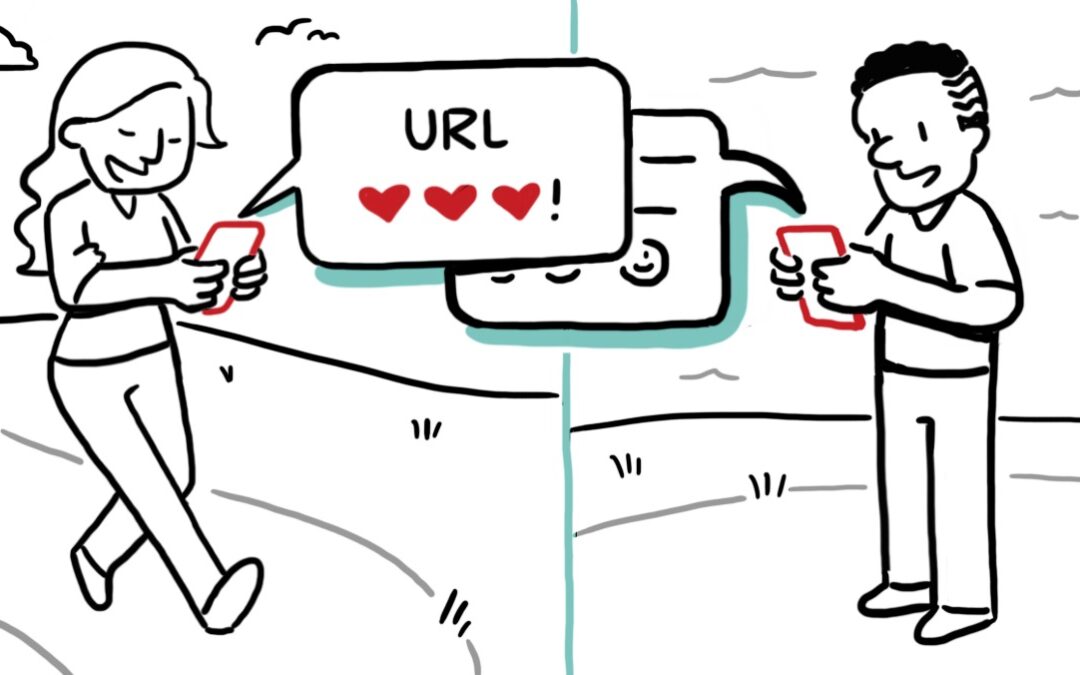Don’t let the name fool you—dark social doesn’t refer to bad press on social media, or to some kind of Stranger Things/Upside Down version of the channels you know and love. Dark social is traffic and sharing that occurs via direct or private connections. Think direct messaging on a social media network. It’s called dark because “this invisible social sharing might as well be happening in the dark.”
The Darkness Grows
This sharing is crucial and becoming more so—already by 2018, over two thirds of content sharing was dark, and the number has only risen in subsequent years. Monthly users of private messaging apps—a key element—outnumbered social network users for most of the 2010’s. The smart marketer, then, should have a dark social strategy high on their list of priorities.
How much do these private channels matter? According to Cydney Hatch, studies show that “84% of outbound sharing [comes] from a business’ or brand’s website happens via private, Dark Social channels.”
Hatch also designates some channels we should understand as dark social channels. Those include messaging apps like Direct DMs, WhatsApp, WeChat, and Facebook Messenger; email; native mobile apps like Facebook and Instagram; and secure browsing channels.
Most relevantly, dark social use continues to rise, particularly in terms of mobile traffic and private messaging. What then, contributes to dark social’s importance?
Believable, Reliable, and Private
As Forbes writer Sayantan Dasgupta explains, “The logic is simple—when someone you know shares something with you in a private forum, you are more likely to consider the source more reliable and trustworthy.”
Simple is right: dark social adds a massive amount of credibility and worth to shared content that your marketers can’t do on their own. No matter how good the campaign, having it shared between friends instead of promoted by a channel will always change the tenor of the experience—for the better. So, how can you plan for a strong dark social showing?
Putting the Team Together
Dasgupta suggests you start your strategy development with a strong and knowledgeable team.
You’ll need a subject and content expert, who can “create trust and demonstrate authority with your buyers;” a creative force, who “should know how to quickly and effectively shoot, produce, and edit the content to be brand conscious and compelling; a project lead, and a ‘social whiz’ who’s well-used to social platforms and intricacies.
That team’s efforts, Dasgupta continues, are central to “grasping your audience’s attention and enticing them to share.” Enticement in the dark social context works differently in a dark social strategy than it does in a conventional content strategy. Instead of quantity and consistency, a dark social strategy should center on your buyer/audience interests and desires.
How can you be sure you’re hitting the right notes? Use yourself as experimental material. When you share content, what is it? Who are you sharing it with, and what makes it relevant?
Creating Community to Compete
The next step is creating a community, writes Tina Morwani, as “dark social channels are a personalized and self-selecting community.” While this certainly doesn’t help those outside of these communities, brands that “are able to access conversations from the inside” can experience a major competitive advantage.
The key to being a part of those conversations? Four basic rules, according to Morwani:
- Create bespoke content. By this, Morwani means avoiding the temptation to recycle messaging from pre-existing campaigns, acknowledging that in these informal forums, such content will stick out as “out of touch and irrelevant,” and will likely drive interest away from your brand.
- Encourage conversations, don’t broadcast. Here, it’s important to remember that dark social channels aren’t meant to be publishing platforms. “Deploying interactive content that has a life beyond the initial share” is far better than projecting your messaging into dark social channels.
- Think beyond traditional marketing objectives. This one gets at the heart of your interaction with dark social: if you’re there for measurable indicators of engagement, you’ve entered the arena with the wrong goals. “Reaching a new, more receptive audience” is a more realistic, achievable goal in dark social channels.
- Avoid the sales talk. This dovetails well with the previous two points—the insular, community-led feel on these channels means brands need to have a reason for being there, beyond a sales pitch.
Remember Your Audience’s Interests
Finally, Morwani argues that “if marketers are going to bring dark social into the light, they need to focus on tapping into peoples’ passions in a personal but sensitive way and demonstrate they understand who their audience is and why they’re using these platforms.”
In other words, good content marketing offers something valuable to its audience. And, crucially, it does so aside from (or instead of) the standard typical sales pitch. Take this ethos one step further, or more seriously, when taking your brand into dark social channels.
The modern consumer, inundated as they are with advertisements, is already tired of the hard sell. They’re even more uninterested in pushy sales efforts on channels they expect to be private and informal. In some sense, dark social channels are a refuge for users. If you’re going to enter that space (which you certainly have good reason to do), do so intelligently. With the right team, the right community, and a light step, you should have no trouble.

